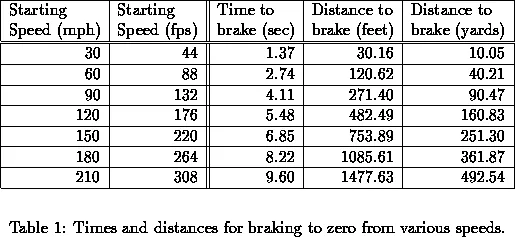No Bucks Racing Club
P.O. Box 662
Burbank, CA 91503
(C)Copyright 1991
I was recently helping to crew Mark Thornton's effort at the Silver State Grand Prix in Nevada. Mark had built a beautiful car with a theoretical top speed of over 200 miles per hour for the 92 mile time trial from Lund to Hiko. Mark had no experience driving at these speeds and asked me as a physicist if I could predict what braking at 200 mph would be like. This month I report on the back-of-the-envelope calculations on braking I did there in the field.
There are a couple of ways of looking at this problem. Brakes work by converting the energy of motion, kinetic energy, into the energy of heat in the brakes. Converting energy from useful forms (motion, electrical, chemical, etc.) to heat is generally called dissipating the energy, because there is no easy way to get it back from heat. If we assume that brakes dissipate energy at a constant rate, then we can immediately conclude that it takes four times as much time to stop from 200 mph as from 100 mph. The reason is that kinetic energy goes up as the square of the speed. Going at twice the speed means you have four times the kinetic energy because
That's pretty simple, but is it right? Do brakes dissipate energy at a constant rate? My guess as a physicist is 'probably not.' The efficiency of the braking process, dissipation, will depend on details of the friction interaction between the brake pads and disks. That interaction is likely to vary with temperature. Most brake pads are formulated to grip harder when hot, but only up to a point. Brake fade occurs when the pads and rotors are overheated. If you continue braking, heating the system even more, the brake fluid will eventually boil and there will be no braking at all. Brake fluid has the function of transmitting the pressure of your foot on the pedal to the brake pads by hydrostatics. If the fluid boils, then the pressure of your foot on the pedal goes into crushing little bubbles of gaseous brake fluid in the brake lines rather than into crushing the pads against the disks. Hence, no brakes.
We now arrive at the second way of looking at this problem. Let us assume that we have good brakes, so that the braking process is limited notby the interaction between the pads and disks but by the interaction between the tires and the ground. In other words, let us assume that our brakes are better than our tires. To keep things simple and back-of-the-envelope, assume that our tires will give us a constant deceleration of

We can immediately see from this table (and, indeed, from the formulas) that it is the distance, not the time, that varies as the square of the starting speed
The numbers in the table are in the ballpark of the braking figures one reads in published tests of high performance cars, so I am inclined to believe that the second way of looking at the problem is the right way. In other words, the assumption that the brakes are better than the tires, so long as they are not overheated, is probably right, and the assumption that brakes dissipate energy at a constant rate is probably wrong because it leads to the conclusion that braking takes more time than it actually does.
My final advice to Mark was to leave lots of room. You can see from the table that stopping from 210 mph takes well over a quarter mile of very hard, precise, threshold braking at 1
[hr]
converted by: rck@home.net
Thu Sep 29 14:12:42 PDT 1994




